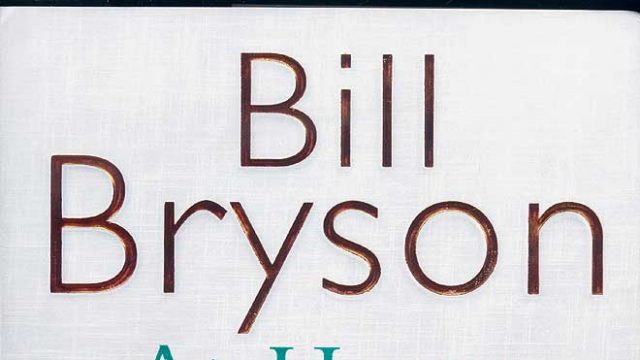Unlikely as it may seem, this book of 500-odd pages about the evolution of the modern home is so lively that you read it at the pace of a murder mystery. That’s because best-selling travel writer and humorist Bill Bryson has a narrative style that allows the reader to glide along, sweat-free and effortless, through vast stretches of political and social history, archaeology and biography, reaching the end of the ride feeling delightfully enriched.
He starts us off in the Hall and passes through each of 17 spaces, pausing for an average of 28 pages in each location before winding up in the Attic. The Dining Room, Garden and Bathroom are among the longest chapters, but each location is treated with the same level of attention and affection, including an odd space called the Plum Room, which doesn’t have any clearly defined function at all. The particular home through which we’re taken is his own — a 19th-century rectory in Norfolk, England. He tells us, in the Introduction, that his inspiration for writing this particular book was a door discovered in his attic which gives him access to a space on the roof, between the front and rear gables. From this vantage point he gets a marvellous view, 50 feet up in the air, of the surrounding countryside.
Contemplating the serene beauty of the obscure little English village of which he is a resident, he is struck by the fact that “in two thousand years of human activity the only thing that had stirred the notice of the outside world even briefly was the finding of a Roman phallic pendant. The rest was just centuries and centuries of people quietly going about their daily business — eating, sleeping, having sex, endeavouring to be amused — and it occurred to me, with the forcefulness of a thought experienced in 360 degrees, that that’s really what history mostly is: masses of people, doing ordinary things… I don’t know how many hours of my school years were spent studying the Missouri Compromise or the War of the Roses, but it was vastly more than I was ever encouraged or allowed to give to the history of eating, sleeping, having sex or endeavouring to be amused.”
And so it begins, an epic tour of that most familiar of spaces, the human home. Each of the rooms through which Bryson pauses, opens onto fascinating vistas. It is as if he has devised a literary version of an advent calendar, with all kinds of treats hidden behind each room-shaped flap. The Bathroom conveys us all the way back to Imperial Rome, for instance, while the Scullery takes us into the hidden reaches of England’s social history, when stately homes contained whole armies of domestic servants, with no laws to protect them against abuse and poor wages. In the Drawing Room our attention is focused on the changing design and deployment of furniture, while the Fuse Box opens up a veritable treasure trove of information about illumination, from the procurement of whale-oil to the halting stages by which the electric light bulb came into being.
In among the mechanical and techno-historical detail are scores of stories that give the book its warm, human scale. From Hannah Cullwick, secretly married to her employer though known to the world only as his maid, to the formidably gifted Joseph Paxton who designed the great exhibition hall of the Victorian Era, the Crystal Palace; from the obscure outpost of early human settlement in the Orkneys called Skara Brae to Eli Whitney, who transformed world history by his invention of the cotton gin, it’s like being whizzed through an astonishing array of human achievements and follies, each in some way leading up to the way some of us live today.
It’s impossible, of course, not to be conscious that the period of England’s Industrial Revolution which forms the core of the book’s attention, is what modern India is currently passing through. Descriptions of social disparities and the lack of civic amenities in England of the 1800s might be applied directly to present-day India’s slums and villages. Reading about those times is, therefore, a bit like being a fly caught in the amber of today, looking wistfully out at what may, if we’re lucky, be our future. Fascinating, sobering, enlightening, in short, a marvellous read.




